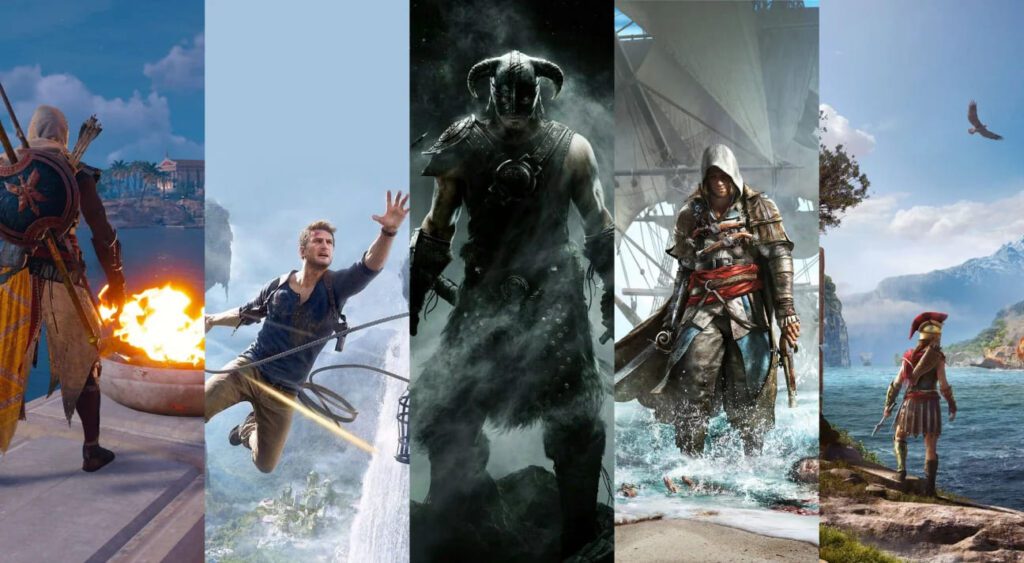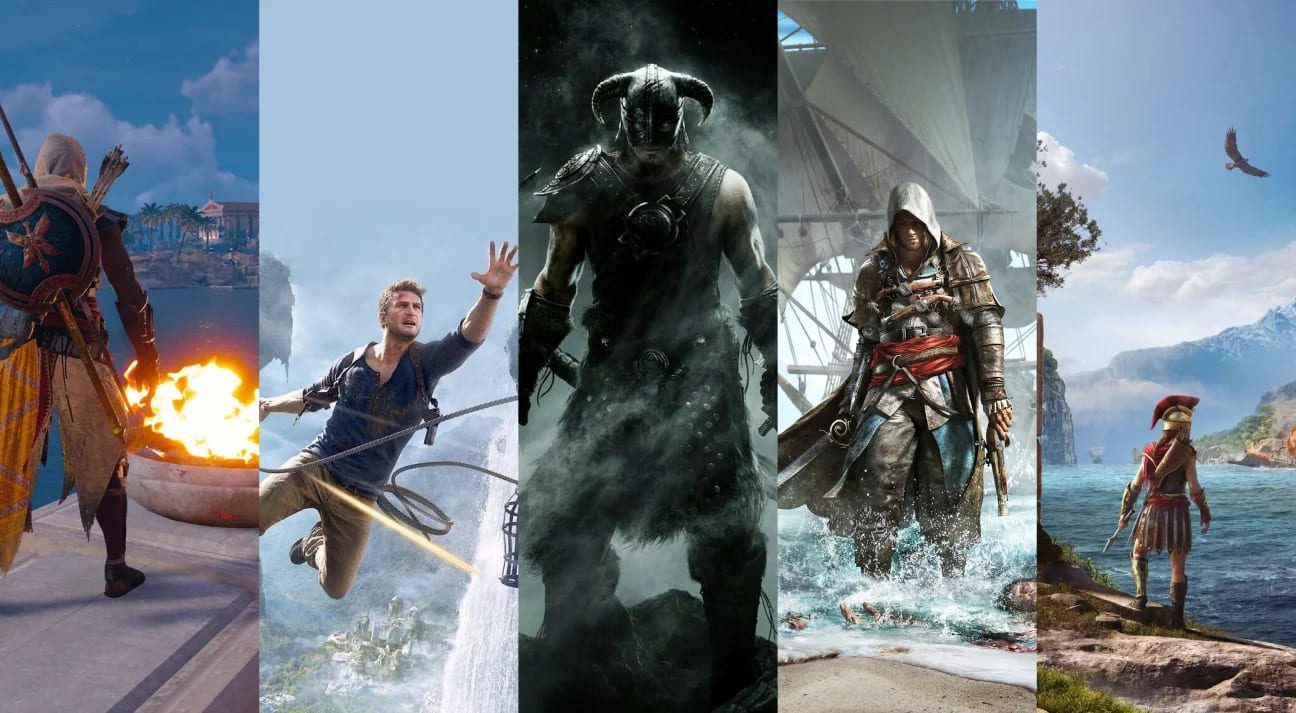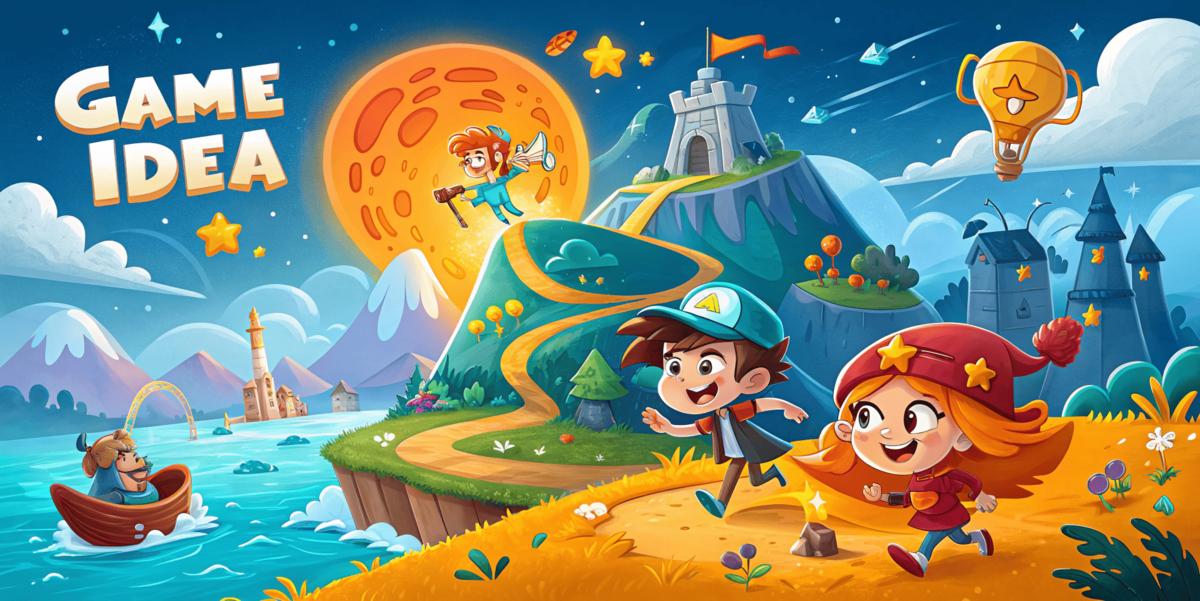When you hear about blockbuster video games with photorealistic graphics, Hollywood-level storytelling, and budgets that rival major motion pictures, you’re talking about AAA games. These triple-A titles represent the pinnacle of gaming production—the industry’s biggest, most ambitious, and most expensive projects.
But what exactly makes a game “AAA”? How much does it cost to create these gaming behemoths? And what are the hottest AAA games coming in 2025? Whether you’re a curious gamer, an aspiring developer, or someone fascinated by the business of gaming, this complete guide breaks down everything you need to know about triple-A games.
What Are AAA Games? The Definition Explained

AAA (pronounced “Triple-A”) is a classification for video games produced or distributed by mid-sized or major publishers, typically featuring higher development and marketing budgets than other tiers of games. Think of AAA games as the Hollywood blockbusters of the gaming world.
Key characteristics that define AAA games:
Massive Development Budgets – We’re talking tens to hundreds of millions of dollars invested in production. Modern AAA games with development budgets approved for 2024-2025 typically cost $200 million or more, a dramatic increase from just five years ago.
Large Development Teams – AAA studios employ hundreds or even thousands of people. These teams include programmers, artists, designers, writers, sound engineers, quality assurance testers, and marketing professionals working together for years.
Major Publisher Backing – AAA games come from industry giants like Electronic Arts, Activision Blizzard, Ubisoft, Sony Interactive Entertainment, Microsoft, Nintendo, Take-Two Interactive, and other major publishers with deep pockets.
High Production Values – Cutting-edge graphics, motion capture technology, Hollywood voice actors, orchestral soundtracks, and cinematic presentation standards set these games apart.
Multi-Platform Releases – Most AAA games launch across multiple platforms (PlayStation, Xbox, PC, sometimes Nintendo Switch) to maximize their market reach and recoup massive investments.
Extensive Marketing Campaigns – AAA games get marketing budgets that can match or exceed their development costs, with television commercials, online advertising, influencer partnerships, and worldwide promotional tours.
The term emerged in the late 1990s and early 2000s as game production became increasingly expensive and sophisticated. Today, AAA games dominate sales charts and cultural conversations, setting the standard for what modern gaming can achieve.
For context on how game development has evolved, understanding the rising costs of AAA game development and exploring what AAA game development entails provides valuable background.
How Much Do AAA Games Actually Cost to Make?
The financial scale of AAA game development is staggering and continues to escalate. Let’s break down the real numbers:
A modern AAA game with a recently approved development budget and launch window of 2024-2025 typically costs $200 million or more, a significant increase from the $50-150 million average of just five years ago.
Where does all that money go?
Staff Salaries (40-50% of budget) – Large teams working for multiple years represent the biggest expense. Senior developers, artists, and designers command high salaries, especially in expensive cities like Los Angeles, San Francisco, or Seattle.
Technology and Tools (10-15%) – Game engines (even licensed ones like Unreal Engine), proprietary technology development, motion capture equipment, and software licenses add up quickly.
Voice Acting and Audio (5-10%) – Hollywood actors, orchestral scores, sound design, and localization for multiple languages cost millions. Games like The Last of Us or Cyberpunk 2077 feature A-list talent that commands premium rates.
Marketing and Promotion (30-50%) – Often matching or exceeding development costs, marketing includes TV commercials, digital advertising, influencer campaigns, press tours, and launch events.
Localization (3-5%) – Translating games into 10-20+ languages with culturally appropriate adaptations requires specialized teams.
Quality Assurance Testing (5-8%) – Hundreds of testers finding bugs across multiple platforms and configurations for months before release.
Licensing and Legal (2-5%) – Music rights, brand partnerships (sports games licensing real teams), legal compliance across markets.
The most expensive game ever made? That distinction likely belongs to a title with a total cost of approximately $265 million including development and marketing.
AAA vs AA vs Indie Games: What’s The Difference?
The gaming industry has multiple tiers, each with distinct characteristics:
AAA Games are the Hollywood blockbusters—massive budgets, huge teams, cutting-edge technology, and global marketing campaigns. They aim for mainstream appeal and must sell millions of copies to be profitable.
AA Games occupy the middle ground—professional production with smaller budgets, often more creative risks, and focused experiences. They don’t need to sell 10 million copies to succeed, allowing for more experimental gameplay.
Indie Games are the independent films of gaming—small teams or solo developers creating passion projects. Lower budgets mean creative freedom, but also limited resources. Success stories like Minecraft or Undertale prove indies can compete with AAA quality.
Understanding these distinctions helps developers choose their path. While AAA games dominate headlines, indie and AA games often deliver more innovation and creative risks. The difference between game design and game development applies across all these tiers, though AAA projects require more specialization.
Top AAA Game Studios and Publishers in 2025
The AAA gaming landscape is dominated by several major players:
Rockstar Games (Take-Two Interactive) – The minds behind Grand Theft Auto and Red Dead Redemption set the gold standard for open-world gaming. Their meticulous attention to detail and willingness to spend years perfecting games creates industry-defining experiences.
CD Projekt Red – The Polish studio behind The Witcher series and Cyberpunk 2077 has become synonymous with ambitious storytelling and expansive open worlds. CD Projekt Red, the AAA game company behind The Witcher III and Cyberpunk 2077, is returning to the Witcher universe with The Witcher IV, featuring Ciri as the new playable protagonist.
Naughty Dog (Sony) – Masters of cinematic gaming, creating narrative-driven experiences like The Last of Us and Uncharted series that blur the line between games and interactive movies.
Bethesda Game Studios (Microsoft) – Known for massive RPGs like The Elder Scrolls and Fallout series, Bethesda creates worlds players can lose themselves in for hundreds of hours.
Epic Games – Beyond creating Fortnite, Epic develops Unreal Engine, the technology powering countless AAA games. Their influence on the industry extends far beyond their own titles. Unity has also proven capable of AAA-quality games with impressive results.
Activision Blizzard (Microsoft) – Publishers of Call of Duty, World of Warcraft, Overwatch, and Diablo, representing multiple genre-defining franchises.
Ubisoft – The French giant behind Assassin’s Creed, Far Cry, Rainbow Six, and many other franchises, known for detailed open worlds and massive production scales.
Electronic Arts (EA) – Sports gaming dominance with FIFA, Madden, and NHL, plus franchises like Battlefield, Mass Effect, and Dragon Age.
Sony Interactive Entertainment – First-party PlayStation exclusives from various studios, including God of War, Spider-Man, Horizon, and Ghost of Tsushima.
Nintendo – While operating differently from other AAA publishers, Nintendo’s first-party titles like Zelda, Mario, and Pokémon receive AAA budgets and polish.
These studios don’t just make games—they set industry trends, pioneer new technologies, and define what’s possible in interactive entertainment.
Most Anticipated AAA Games Coming in 2025
Even though Grand Theft Auto 6 doesn’t release this year, plenty of titles thrilled gaming audiences, and the year is packed with highly anticipated releases:
Grand Theft Auto VI – The gaming event of the decade. Rockstar’s return to the GTA universe with a Vice City setting promises to redefine open-world gaming once again. Expected to break all sales records.
The Witcher IV – CD Projekt Red’s upcoming single-player open-world RPG shifts the spotlight to Ciri, Geralt of Rivia’s adopted daughter, as the new playable protagonist.
DOOM: The Dark Ages – DOOM: The Dark Ages is streamlining controls, simplifying upgrades, and providing custom difficulty sliders to finely-tune the challenge, including flying a 30-story Atlan mech or soaring on a cyborg dragon to take on Hell’s armies.
Ghost of Yōtei – Sony’s follow-up to the acclaimed Ghost of Tsushima, continuing their run of stunning single-player experiences set in feudal Japan.
Monster Hunter Wilds – Capcom’s next entry in their monster-slaying franchise promises new environments, creatures, and gameplay mechanics for solo and co-op play.
Death Stranding 2: On The Beach – Hideo Kojima’s follow-up to his divisive but fascinating post-apocalyptic delivery simulator.
Assassin’s Creed Shadows – Ubisoft’s historical action series finally ventures to feudal Japan, fulfilling a long-standing fan request.
Fable – The beloved fantasy RPG series returns under Playground Games (Forza Horizon developers), promising British humor and moral choices.
Avowed – Obsidian Entertainment’s first-person fantasy RPG set in the Pillars of Eternity universe, targeting fans of Elder Scrolls-style adventures.
Kingdom Come: Deliverance 2 – The sequel to the realistic medieval RPG that impressed history buffs with its attention to detail.
Metal Gear Solid Delta: Snake Eater – A remake of the beloved PS2 classic, bringing Kojima’s stealth masterpiece to modern platforms.
Crimson Desert – Pearl Abyss’s ambitious open-world action-adventure game promising massive scale and dynamic combat.
Battlefield 6 – Their upcoming flagship shooter is already being hailed online as one of the best AAA games of 2025 and a glorious return to the series’ roots.
The 2025 games calendar grows longer with late-year heavy hitters like Silksong, Battlefield 6, and Bloodlines 2.
The variety here showcases AAA gaming’s breadth—from photorealistic open worlds to stylized action games, from solo narrative experiences to massive multiplayer battlefields.
The Technology Behind AAA Games

What separates AAA games technically from smaller productions?
Game Engines:
- Unreal Engine 5 – Epic’s latest engine powers many AAA projects with photorealistic graphics, Nanite geometry, and Lumen lighting
- Proprietary Engines – Studios like Rockstar (RAGE), CD Projekt (REDengine), and Bethesda (Creation Engine) develop custom technology for their specific needs
- Unity – While traditionally associated with indies, Unity has powered impressive AAA-quality titles
Graphics and Visual Fidelity:
- Ray tracing for realistic lighting and reflections
- Motion capture for lifelike character animations
- Photogrammetry scanning real-world objects for game assets
- Advanced physics simulations for cloth, water, and destruction
- 4K and even 8K resolution support
Audio Design:
- 3D spatial audio creating immersive soundscapes
- Orchestral scores recorded with full orchestras
- Thousands of unique sound effects
- Dynamic music that responds to gameplay
- Professional voice acting with motion capture
AI and Systems:
- Complex NPC behavior creating believable worlds
- Dynamic weather and day/night cycles
- Procedural generation for varied content
- Advanced pathfinding and combat AI
- Systemic gameplay where elements interact organically
Online Infrastructure:
- Massive multiplayer servers supporting thousands of concurrent players
- Anti-cheat systems
- Matchmaking algorithms
- Content delivery networks for updates
- Cross-platform play compatibility
The technical sophistication of AAA games requires massive teams and years of development. Artificial intelligence is making NPCs smarter and more believable, while advancements in game art and visual design push boundaries constantly.
The AAA Game Development Process
Creating a AAA game involves distinct phases over multiple years:
Phase 1: Pre-Production (6-18 months)
Concept Development – High-level vision, target audience, and core gameplay pillars
Prototyping – Testing core mechanics and gameplay loops early
Technical Planning – Engine selection, pipeline development, tools creation
Team Building – Hiring key personnel and assembling the core team
Budget and Schedule – Creating realistic timelines and financial projections
Phase 2: Production (2-4 years)
Content Creation – The bulk of development work happens here:
- Level design and world building
- Character modeling and animation
- Programming gameplay systems
- Creating art assets by the thousands
- Recording voice acting and music
- Writing dialogue and story
- Building UI/UX systems
Vertical Slice – Creating one fully polished section that represents the final game’s quality
Iterative Development – Constant playtesting, feedback, and refinement
Understanding the key stages of game development helps navigate this complex process.
Phase 3: Alpha to Beta (6-12 months)
Alpha – All features implemented, content mostly complete but rough Beta – Content complete, focus shifts to polishing and bug fixing Quality Assurance – Intensive testing across all platforms to eliminate bugs Optimization – Making the game run smoothly on target hardware Localization – Translating and adapting for global markets
Phase 4: Gold and Launch (2-4 months)
Gold Master – Final version submitted for platform certification Manufacturing – Physical copies produced and distributed Day One Patch – Fixing issues found too late for the disc version Marketing Blitz – Final promotional push before release Launch – The big day when the game releases
Phase 5: Post-Launch (Ongoing)
Live Service – Updates, patches, and additional content DLC and Expansions – Planned additional content extending the game’s life Community Management – Engaging with players and addressing feedback Technical Support – Fixing bugs and maintaining servers
The timeline for AAA development can stretch 5-7 years or more. Red Dead Redemption 2 took roughly 8 years, while games like Duke Nukem Forever spent over a decade in development hell.
The Business Model: How AAA Games Make Money
With budgets exceeding $200 million, AAA games need multiple revenue streams:
Traditional Game Sales ($60-70 at launch)
- Still the primary revenue source
- Digital sales now exceed physical copies
- Must sell millions to break even
- First week sales crucial for success
Special Editions ($80-$150+)
- Deluxe versions with extra content
- Collector’s editions with physical merchandise
- Season passes for future DLC
Downloadable Content (DLC)
- Story expansions ($15-30)
- Cosmetic items
- New characters or maps
- Extends the game’s profitable lifespan
Microtransactions
- In-game currency
- Cosmetic items (skins, emotes)
- Battle passes
- Controversial but highly profitable
Subscription Services
- Xbox Game Pass, PlayStation Plus
- Publishers get upfront payment
- Increases player base even if per-player revenue is lower
Merchandise and Licensing
- T-shirts, figures, collectibles
- Board game adaptations
- Novel and comic tie-ins
Esports and Competitive Gaming
- Streaming rights
- Tournament sponsorships
- In-game tournament passes
The Reality: Most AAA games need to sell 5-10 million copies to be profitable. Blockbusters like GTA V or Elden Ring selling 20-30+ million copies are exceptional. Many AAA games fail to recoup their investment, leading to studio closures or cancellations of planned sequels.
This financial pressure shapes game design, often prioritizing safe sequels over risky new IPs. It also drives the controversial microtransactions and “games as service” models that keep revenue flowing years after launch.
Pros and Cons of AAA Game Development
Advantages ✅
Cutting-Edge Experiences – The best graphics, gameplay, and production values money can buy create unforgettable experiences.
Industry Innovation – AAA budgets allow studios to push technological boundaries and pioneer new techniques that benefit the entire industry.
Career Opportunities – Working on AAA games provides prestige, learning opportunities, and competitive salaries for developers.
Cultural Impact – AAA games dominate conversations, create fandoms, and influence broader entertainment.
Financial Rewards – Successful AAA games generate billions, funding future projects and studio expansion.
Disadvantages ⚠️
Massive Financial Risk – One failure can bankrupt studios or lead to mass layoffs. The video game industry in 2025 was still in midst of large-scale layoffs since 2022.
Creative Conservatism – Huge budgets encourage safe sequels over innovative new concepts. Publishers fear alienating audiences.
Crunch Culture – Meeting deadlines often means mandatory overtime, leading to burnout and poor work-life balance.
Long Development Cycles – Developers might work on one game for 5+ years, which can be creatively stifling.
Homogenization – AAA games often feel similar, chasing proven formulas rather than experimenting.
Market Saturation – Too many AAA games release simultaneously, cannibalizing each other’s sales.
Unrealistic Player Expectations – Gamers expect every AAA game to be a masterpiece, creating unsustainable pressure.
The AAA model faces increasing scrutiny. Rising costs, longer development times, and market risks have many questioning if the model is sustainable long-term.
Can Indie Developers Create AAA-Quality Games?
This question sparks passionate debates. The short answer: it’s incredibly difficult but not impossible.
What Indies Can Achieve:
- High-quality art direction (Hollow Knight, Cuphead)
- Compelling narratives (Disco Elysium, What Remains of Edith Finch)
- Innovative gameplay (Portal was created by a small team)
- Technical excellence (Stray, Kena: Bridge of Spirits)
Where Indies Struggle:
- Scope and scale of massive open worlds
- Photorealistic graphics requiring specialized teams
- Orchestral soundtracks and Hollywood voice talent
- Marketing reach and visibility
- Multi-platform simultaneous launches
- Post-launch support and updates
The Middle Ground: Some projects blur the lines. Games like Hellblade: Senua’s Sacrifice were created by small teams with AAA-level polish in specific areas while being smart about scope. These “AAA indie” or “AA” games prove you don’t need $200 million to create impactful experiences.
For developers interested in creating games across various scales, exploring mobile game development, Android game development, or iOS game development can provide stepping stones toward larger projects.
The Future of AAA Gaming
Where is AAA gaming headed? Several trends are shaping the next decade:
Cloud Gaming – Services like Xbox Cloud Gaming and GeForce Now may eliminate hardware barriers, allowing AAA games to reach anyone with internet.
AI-Assisted Development – Artificial intelligence could reduce costs and development time by automating asset creation, bug detection, and even level design. AI game development is already impacting the industry.
Virtual Reality AAA – As VR technology improves and becomes more affordable, we’ll see more AAA studios investing in virtual reality experiences. Imagine playing the best horror games in full VR with AAA production values.
Cross-Platform Everything – Crossplay support is becoming standard, with games playable across PC, consoles, and mobile seamlessly.
Subscription Dominance – Game Pass, PlayStation Plus, and similar services may become the primary way players access AAA games.
Shorter Development Cycles – Industry pressure to reduce 5-7 year development times through better tools, more outsourcing, and smarter production pipelines.
Blockchain and NFTs? – Despite controversy, some publishers experiment with Web3 and NFT integration, though reception remains mixed.
Sustainability Questions – Can the $300+ million game model survive? Or will we see a shift toward smaller, more focused AAA projects?
Remote Development – Post-pandemic, many AAA studios embrace remote work, potentially reducing costs and expanding talent pools globally.
The industry stands at a crossroads. Rising costs and risks threaten the traditional AAA model, while new technologies and distribution methods offer solutions. The next few years will determine whether AAA gaming evolves or implodes under its own weight.
How to Break Into AAA Game Development
Want to work on the next GTA or The Witcher? Here’s the realistic path:
Education Foundation:
- Computer Science or Game Development degree (though not mandatory)
- Online courses from places like top game development schools
- Self-taught programming, art, or design skills
- Specialization is key—master one discipline
Build Your Portfolio:
- Create personal projects demonstrating your skills
- Contribute to open-source game projects
- Participate in game jams
- Build a professional website showcasing your best work
- Understanding how long it takes to make a game helps set realistic expectations
Start Smaller:
- Most AAA developers don’t start in AAA
- Begin with indie studios or AA companies
- Mobile game studios can provide valuable experience
- Build your network and skills over 3-5 years
Choose Your Specialization:
- Programming: Gameplay, AI, graphics, tools, engine
- Art: Concept art, 3D modeling, animation, VFX
- Design: Level design, systems design, UI/UX
- Audio: Sound design, music composition, audio programming
- Production: Project management, production coordination
Know the Tools:
- Unity vs Unreal Engine – master at least one
- Maya vs Blender for 3D art
- Version control (Perforce, Git)
- Collaboration tools (Jira, Confluence)
Network Relentlessly:
- Attend game development conferences (GDC, SIGGRAPH)
- Join online communities and Discord servers
- Connect with developers on LinkedIn and Twitter
- Don’t be afraid to reach out for informational interviews
Apply Strategically:
- Target junior positions at AAA studios
- QA testing is a common entry point
- Contract positions can lead to full-time roles
- Be persistent—rejection is normal
Keep Learning:
- AAA development requires constant skill updates
- Follow industry trends and new technologies
- Take online courses and tutorials
- Never stop building personal projects
Breaking into AAA is challenging but absolutely possible with dedication, skill, and persistence. The industry needs talented people, and studios constantly hire.



